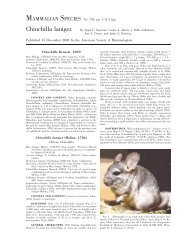Brugia Malayi - Clark Science Center - Smith College
Brugia Malayi - Clark Science Center - Smith College
Brugia Malayi - Clark Science Center - Smith College
Create successful ePaper yourself
Turn your PDF publications into a flip-book with our unique Google optimized e-Paper software.
Neuroendocrinology of Sociality in Meadow Voles<br />
Kara Reitz<br />
There is a lot of interest in the neurobiology of social behavior. However, little is understood about mechanisms supporting<br />
relationships between individuals who are not mates. In the summer months female meadow voles (Microtus pennsylvanicus) are<br />
reproductively receptive and are also extremely territorial and solitary. In the winter months voles are markedly more social and will<br />
exhibit more huddling behavior among their peers. The aim of this study was to examine the role of seasonal variation in anxiety in<br />
non-reproductive affiliative behaviors in meadow voles by reducing anxiety with diazepam and by manipulating day-length cycles.<br />
Voles were reared in two different day lengths to simulate the light shifts in summer and winter months: long day (14 hours of<br />
light, 10 hours of dark) and short day (10 hours of light, 14 of dark). They were also assigned to three distinct drug treatment groups<br />
that included a high dose of diazepam, a low dose of diazepam, or saline. To examine anxious behavior three anxiety tests were<br />
given over a two-week period: the elevated plus-maze, light/dark box and open field tests. Following this sequence of anxiety tests a<br />
partner preference test was given to examine the social behavior of the voles. The partner preference test consists of three chambers:<br />
two tethered voles on each end of the apparatus and a free vole. The free vole was allowed to roam between the chambers over a<br />
three-hour period and the time spent huddling versus alone was then analyzed. In order to examine the effect of diazepam, it was<br />
administered before partner preference tests and the EPM.<br />
Based on what is known about both the anxiety and social behavior of meadow voles, it is expected that short day voles will<br />
exhibit more social behavior in the partner preference tests and lower anxiety in other behavioral tests. Conversely, long day voles<br />
are expected to exhibit less social behavior in the partner preference tests and more anxiety in the other behavioral tests. Diazepam<br />
is expected to reduce anxiety behaviors in the EPM and may alter social behaviors in partner preference tests across one or both day<br />
lengths.<br />
Thus far there has not been much research done on the formation of non-reproductive social relationships in mammals, and<br />
this study aims to characterize natural variation in anxiety as a mediator of social behavior. (Supported by the Frances Baker Holmes<br />
Fund)<br />
Advisor: Annaliese Beery<br />
References:<br />
Hendrie, C.A., Eliam, D., Weiss, S.M. 1997. Effects of diazepam and buspirone on the behaviour of wild voles (Microtus socialis) in two models of anxiety. Pharmacol<br />
Biochem Behav 58, 573-576.<br />
Ossenkopp, K.P., van Anders, S.M., Engeland, C.G., Kavaliers, M. 2005. Influence of photoperiod and sex on locomotor behavior of meadow voles (Microtus<br />
pennsylvanicus) in an automated light-dark ‘anxiety’ test. Psychoneuroendocrinology 30, 869-879.<br />
2012<br />
154

















